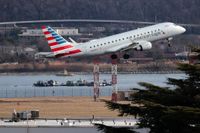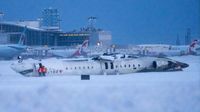Recent aviation disasters are sending shockwaves through the airline industry, leading to a significant decline in ticket sales amid heightened consumer fear of flying. Major airlines are grappling with these challenges following two catastrophic incidents that have shaken public confidence in air travel.
At an investors conference this week, Delta Air Lines CEO Ed Bastian laid bare the impact that the tragic events have had on air travel. He noted that recent incidents, including a fatal crash in Washington, D.C., and a non-fatal accident in Toronto, have contributed to a sharp decline in revenue growth predictions for the airline.
Speaking candidly to CNN, Bastian remarked, "There’s a whole generation of people traveling these days who didn’t realize these things can happen." His comments reflect a broader sentiment, acknowledging how these flying fears have affected travelers who may be reconsidering their plans. The Washington D.C. disaster, which claimed the lives of 67 individuals after an American Airlines flight collided with a military helicopter in January 2025, has profoundly unsettled consumers.
The situation worsened when a month later, a Delta flight arriving in Toronto flipped upside down during landing, although all passengers and crew on board were fortunate enough to escape unscathed. Bastian noted that incidents like these are among the worst the aviation industry has seen in the last 25 years.
As both incidents continue to be scrutinized, the National Transportation Safety Board remains engaged in ongoing investigations to determine their exact causes. Until clarity is obtained, the aviation sector faces a growing challenge in reassuring the public about flight safety.
Furthermore, the impact of these incidents runs parallel to existing economic concerns, with Bastian highlighting the intertwining nature of travel confidence and economic stability, stating, "Consumer confidence and certainty in air travel started to wane a little bit as questions of safety came in." Many potential flyers are reassessing their plans not only in light of these recent tragedies but also due to rising costs of living and overall financial uncertainties.
American Airlines, too, is feeling the pinch. CEO Robert Isom remarked that the revenue forecast for his airline had also taken a hit following the D.C. crash. He prioritized the care and support of the victims’ families, acknowledging the gravity of the loss and the sentiments surrounding it. Isom echoed Bastian's concerns about economic conditions impacting airline performance, characterizing the situation from an operational perspective as a "big deal." This dual focus on human compassion and business realities marks an interesting pivot in how airlines respond to tragedies.
The fallout from these events could have long-lasting implications on airline profit margins, as Bastian revealed that Delta has cut its revenue growth expectations for the upcoming quarter by half. The “immediate stall in both corporate travel and bookings” indicates that the risks perceived by consumers will likely lead to a more cautious market, pushing travelers toward alternatives or postponements.
As industry leaders address these alarming trends, they’ve committed to improving safety and communication strategies to regain public trust. Business analysts are closely monitoring these developments, noting that it may take time for the industry to fully recover from the psychological impacts of fear tied to flying.
As investigations into the crashes uncover more details, it will be crucial for airlines to take proactive steps to reinforce safety protocols. The path forward will likely require collaboration with regulatory bodies and a transparent approach to managing passenger safety concerns.
While the airlines strive to navigate these turbulent skies, it remains to be seen how effective their strategies will be in reshaping public perception and restoring confidence in air travel. For many, this period could redefine how they view the experience of flying altogether.
The airline industry is facing a pivotal moment, grappling with both immediate reactions from the flying public and deeper systemic issues associated with economic fluctuations. The road to recovery hinges on restoring customer loyalty and trust, an endeavor that may prove challenging in the wake of such deeply unsettling incidents.
In conclusion, the recent aviation tragedies underscore the fragility of public confidence in flying amidst escalating safety concerns and economic pressures. As airlines adapt to a changing landscape, the focus on safety and transparent communication may be vital to restoring the sickened affinity for air travel among consumers.





